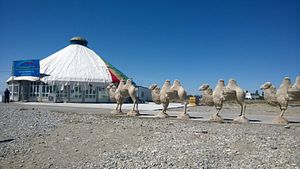Turkic peoples — including Turks, Azerbaijanis, Kazakhs, Uzbeks, Kyrgyzs, and Uyghurs — make up the largest ethnic group in the Central Asian region and in China’s northwestern province of Xinjiang. Uyghurs, a Turkic-Muslim ethnic group native to Xinjiang, make up almost 50 percent of the population there. Most of these groups speak closely related Turkic languages.
Notably, Central Asia and China’s Xinjiang play strategic roles in China’s “One Belt One Road (OBOR).” OBOR will see the construction of overland road and rail routes, oil and natural gas pipelines, and other infrastructure projects stretching from Xi’an in central China through Central Asia and beyond, to European countries. In China’s quest to explore and tap into greater economic opportunities along OBOR, it should bear in mind the importance of people-to-people exchanges with the predominantly Turkic populations of Central Asian countries. Fostering understanding of Turkic cultures and languages will serve as a bridge linking the Central Asian economies and China via Xinjiang, both economically and culturally.
Turkic Language and Culture: Enhancing the OBOR
Given the overwhelming number of Turkic people along China’s OBOR, interest in Turkic language and culture is to be expected. Chinese engagements with the Turkic peoples will open up new spaces for Chinese businesses to seize lucrative opportunities. Along with this, understanding and respect for the local cultural norms observed by the Turkic people, including their religious customs, will also create a favorable impression on the people there. This will enhance the prospects for Chinese companies to continue doing business.
Central Asia and Xinjiang are specifically envisioned as playing a key role in OBOR. In particular, China has already enhanced access to key energy and mineral resources through the construction of a gas pipeline between China and Central Asia. Originating in Turkmenistan, the pipeline will traverse Uzbekistan and Kazakhstan before feeding into China’s West-East pipeline network. A fourth line currently being built will transport gas in Tajikistan and transit through Uzbekistan and Kyrgyzstan, expanding the network into every Central Asian state. These developments will likely spur a growth of Chinese businesses in Central Asia.
China’s economic projects in Central Asia are the first leg of OBOR. China’s National Development and Reform Commission’s (NDRC) policy paper, issued in March 2015, stressed the importance of opening up and exploring the “routes of trade and cultural exchanges that linked the major civilizations of Asia, Europe and Africa.” It is in this light that the role of Turkic language and culture in enhancing people-to-people exchanges and opening up economic opportunities for China in Central Asia should be emphasized.
Xinjiang’s Uyghurs
Xinjiang, China’s restive western frontier region, is home to a large number of Turkic Muslims, a majority of them Uyghurs. Apart from the Uyghurs, there are also smaller communities of other Central Asian peoples (e.g., Kazakh, Kyrgyz, Mongols, and Tajiks). There remain a small minority of politically-driven Uyghurs who are seeking to secede from Xinjiang, either through violent or peaceful means.
The history of struggle by Uyghur nationalists dates back to 1949, when Uyghur separatists sought to establish an independent Eastern Turkestan in Xinjiang. In 1990, an armed confrontation between Uyghurs and Chinese forces known as the “Baren uprising” took place in Kizilsu Kyrgyz Autonomous Prefecture in Xinjiang, leading to the deaths of more than 1,000 Uyghurs and Chinese troops.
Continuing instability in Xinjiang explains much of the suspicion with which the Chinese government has tended to view Uyghurs. China is concerned about the possible existence of radical Uyghur elements embedded within communities. As a result, China has positioned its Muslim Hui Chinese, who are not of Turkic origins, as economic emissaries to the Turkic-speaking countries. This passes up a valuable opportunity for engaging with the Turkic peoples of Central Asia; Chinese Hui Muslims are ethnically and linguistically closer to the Chinese.
However, the intensification of Uyghur (and Tibetan) opposition to ongoing Chinese rule has also underlined for Beijing the need to increase economic development and modernization in Xinjiang in a bid to better integrate the region with the rest of the modern Chinese state. The economic development and modernization drive in Xinjiang will increase the need for people-to-people exchanges between Chinese businesses from Xinjiang and China’s western neighbors. This could provide a boost to OBOR, as a sense of ethnic solidarity binds the Uyghurs and the Turkic-majority in Central Asian countries.
On the other hand, an understanding of Turkic language and culture will be a strategic asset for Chinese businesses seeking to make inroads in either Xinjiang or Central Asia. Increased familiarity and awareness of the Turkic people’s way of life may also serve to mitigate the negative interactions between the Uyghurs in Xinjiang and the Chinese workers in the region.
Conclusion
A greater understanding of Turkic culture and Turkic language will not only enhance the receptivity of the Turkic peoples in Central Asian countries toward Chinese businesses, easing the process of doing business in countries along OBOR, it will also give Chinese businesses an edge compared to rival competitors in the overwhelmingly Turkic-Muslim region.
At the same time, there will be challenges. As China seeks to enhance connectivity with the economies of western neighbors through OBOR to enhance its influence in the region, a key challenge will be for China to manage the security concerns associated with an increase in interconnectivity across borders. Increased connectivity may potentially open up possibilities for extremism, terrorism, and other hostile external elements to be transmitted. The existence of small numbers of Uyghur militants operating with the assistance of the Afghan and Pakistani Taliban along the Western Af-Pak frontier provide evidence of these challenges.
Stefanie Kam Li Yee is an Associate Research Fellow at the International Center for Political Violence and Terrorism Research (ICPVTR) at S. Rajaratnam School of International Studies (RSIS), Nanyang Technological University, Singapore.

































